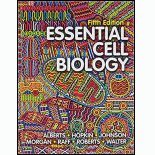
A.
To explain: The mechanism through which ionizing radiations halt cell division.
Concept introduction: Ionizing radiations are those that ionize atoms or molecules by liberating electrons from their shell with the energy they discharge. Ionizing radiations consist of
B.
To explain: The effect of mutation in a cell that prevents the cell from halting cell division even after exposure to ionizing radiation
Concept introduction: Ionizing radiations are those that ionize atoms or molecules by liberating electrons from their shell with the energy they discharge. Ionizing radiations consist of electromagnetic (EM) waves at the high end of the EM spectrum, atoms, ions, and subatomic particles moving at high velocity. Examples of ionizing radiations include γ-rays, X-rays, and UV rays of high end EM spectra. Specialized instruments are used to measure the levels of ionizing radiations, as they cause hazardous effects on the cells by damaging the DNA thereby cell death.
C.
To explain: The effect of mutation in a cell that prevents the cell from halting cell division, but the cell is unexposed to ionizing radiation
Concept introduction: Ionizing radiations are those that ionize atoms or molecules by liberating electrons from their shell with the energy they discharge. Ionizing radiations consist of electromagnetic (EM) waves at the high end of the EM spectrum, atoms, ions, and subatomic particles moving at high velocity. Examples of ionizing radiations include γ-rays, X-rays, and UV rays of high end EM spectra. Specialized instruments are used to measure the levels of ionizing radiations, as they cause hazardous effects on the cells by damaging the DNA thereby cell death.
D.
To explain: The reason why adult human beings should avoid large doses of ionizing radiation as it leads to death.
Concept introduction: Ionizing radiations are those that ionize atoms or molecules by liberating electrons from their shell with the energy they discharge. Ionizing radiations consist of electromagnetic (EM) waves at the high end of the EM spectrum, atoms, ions, and subatomic particles moving at high velocity. Examples of ionizing radiations include γ-rays, X-rays, and UV rays of high end EM spectra. Specialized instruments are used to measure the levels of ionizing radiations, as they cause hazardous effects on the cells by damaging the DNA thereby cell death.
Want to see the full answer?
Check out a sample textbook solution
Chapter 18 Solutions
Essential Cell Biology 5e
- series of two-point crosses were carried out among six loci (a, b, c, d, e and f), producing the following recombination frequencies. According to the data below, the genes can be placed into how many different linkage groups? Loci a and b Percent Recombination 50 a and c 14 a and d 10 a and e 50 a and f 50 b and c 50 b and d 50 b and e 35 b and f 20 c and d 5 c and e 50 c and f 50 d and e 50 d and f 50 18 e and f Selected Answer: n6 Draw genetic maps for the linkage groups for the data in question #5. Please use the format given below to indicate the genetic distances. Z e.g. Linkage group 1=P____5 mu__Q____12 mu R 38 mu 5 Linkage group 2-X_____3 mu__Y_4 mu sanightarrow_forwardWhat settings would being able to isolate individual bacteria colonies from a mixed bacterial culture be useful?arrow_forwardCan I get a handwritten answer please. I'm having a hard time understanding this process. Thanksarrow_forward
- Biology How many grams of sucrose would you add to 100mL of water to make a 100 mL of 5% (w/v) sucrosesolution?arrow_forwardWhich marker does this DNA 5ʹ AATTGGCAATTGGCAATTGGCAATTGGCAATTGGCAATTGGCAATTGGC 3ʹ show?arrow_forwardThe Z value of LOD for two genes is 4, what does it mean for linkage and inheritance?arrow_forward
- Biology How will you make a 50-ul reaction mixture with 2uM primer DNA using 10 uM primer DNA stocksolution and water?arrow_forwardBiology You’re going to make 1% (w/v) agarose gel in 0.5XTBE buffer 100 ml. How much agarose are you goingto add to 100 ml of buffer? The volume of agaroseis negligible.arrow_forwardBiology How will you make a 50-ul reaction mixture with0.2 mM dNTP using 2-mM dNTP stock solution andwater?arrow_forward
 Human Anatomy & Physiology (11th Edition)BiologyISBN:9780134580999Author:Elaine N. Marieb, Katja N. HoehnPublisher:PEARSON
Human Anatomy & Physiology (11th Edition)BiologyISBN:9780134580999Author:Elaine N. Marieb, Katja N. HoehnPublisher:PEARSON Biology 2eBiologyISBN:9781947172517Author:Matthew Douglas, Jung Choi, Mary Ann ClarkPublisher:OpenStax
Biology 2eBiologyISBN:9781947172517Author:Matthew Douglas, Jung Choi, Mary Ann ClarkPublisher:OpenStax Anatomy & PhysiologyBiologyISBN:9781259398629Author:McKinley, Michael P., O'loughlin, Valerie Dean, Bidle, Theresa StouterPublisher:Mcgraw Hill Education,
Anatomy & PhysiologyBiologyISBN:9781259398629Author:McKinley, Michael P., O'loughlin, Valerie Dean, Bidle, Theresa StouterPublisher:Mcgraw Hill Education, Molecular Biology of the Cell (Sixth Edition)BiologyISBN:9780815344322Author:Bruce Alberts, Alexander D. Johnson, Julian Lewis, David Morgan, Martin Raff, Keith Roberts, Peter WalterPublisher:W. W. Norton & Company
Molecular Biology of the Cell (Sixth Edition)BiologyISBN:9780815344322Author:Bruce Alberts, Alexander D. Johnson, Julian Lewis, David Morgan, Martin Raff, Keith Roberts, Peter WalterPublisher:W. W. Norton & Company Laboratory Manual For Human Anatomy & PhysiologyBiologyISBN:9781260159363Author:Martin, Terry R., Prentice-craver, CynthiaPublisher:McGraw-Hill Publishing Co.
Laboratory Manual For Human Anatomy & PhysiologyBiologyISBN:9781260159363Author:Martin, Terry R., Prentice-craver, CynthiaPublisher:McGraw-Hill Publishing Co. Inquiry Into Life (16th Edition)BiologyISBN:9781260231700Author:Sylvia S. Mader, Michael WindelspechtPublisher:McGraw Hill Education
Inquiry Into Life (16th Edition)BiologyISBN:9781260231700Author:Sylvia S. Mader, Michael WindelspechtPublisher:McGraw Hill Education





